 W
WArchaeopotamus is an extinct genus of Hippopotamidae that lived between 7.5 and 2.58 million years ago in Africa and the Middle East. The genus was described in 2005 to encompass species of hippos that were previously grouped in Hexaprotodon.
 W
WThe aurochs, also known as urus or ure, is an extinct cattle species that was first described in 1827. It was native to Asia, Europe and North Africa and survived in Europe until 1627, when the last recorded aurochs, a female, died in Jaktorów forest in Poland. It is the ancestor of domestic cattle. During the Neolithic Revolution at least two aurochs domestication events occurred: one involving the Indian aurochs leading to the zebu cattle and the other involving the Eurasian aurochs subspecies leading to the taurine cattle. Many breeds of modern cattle share characteristics of the aurochs, such as the dark colour in the bulls with a light eel stripe along the back, the cows being of a lighter colour, or an aurochs-like horn shape.
 W
WBlastomeryx is an extinct genus of musk deer endemic to North America. It lived during the Miocene epoch 20.4—10.3 mya, existing for approximately 10 million years. There may be only one species, Blastomeryx gemmifer.
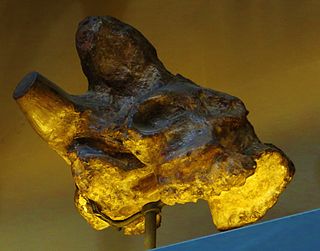 W
WBramatherium is an extinct genus of giraffids that ranged from India to Turkey in Asia. It is closely related to the larger Sivatherium.
 W
WCamelini is a tribe of terrestrial herbivores in the family Camelidae, endemic to Asia, North America, and Africa from the Late Eocene to the present. It includes the living genus Camelus as the type genus. At least one genus, Eulamaops, reached South America.
 W
WCamelops is an extinct genus of camels that lived in North and Central America, ranging from Alaska to Honduras, from the middle Pliocene to the end of the Pleistocene. It is more closely related to the Old World dromedary and bactrian and wild bactrian camels than the New World guanaco and vicuña, and alpaca and llama, making it a true camel of the Camelini tribe. Its name is derived from the Ancient Greek κάμηλος and ὄψ, i.e. "camel-face".
 W
WCelebochoerus is an extinct genus of giant suid artiodactyl that existed during the Pliocene and Pleistocene in Sulawesi, Indonesia, and the middle Pleistocene of Luzon, in the Philippines.
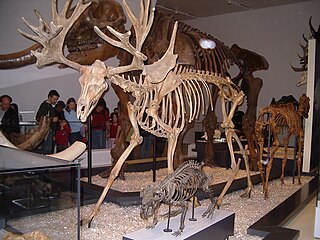 W
WCervalces is an extinct deer genus that lived during the Pliocene and Pleistocene epochs. Cervalces gallicus is either classified as a species of the related Libralces, or an ancestral species to other members of Cervalces. It lived in Europe from the Pliocene to the Pleistocene. Cervalces scotti, the stag-moose, lived in Pleistocene North America. Cervalces latifrons, the broad-fronted moose, and Cervalces carnutorum were found in Pleistocene Europe and Asia.
 W
WCervavitus is a genus of prehistoric deer that lived from the late Miocene to the Early Pleistocene in parts of Western and Eastern Europe, Central Asia and China. It is characterized by having thorny antlers finished in two or three points, brachyodont teeth, molars with a primitive fold and complete lateral metacarpals on their feet, which would serve to move through slope areas. Due to its particular position in the systematics and phylogeny of deer, is considered to form part of the first branches of cervids more advanced than the muntiacines, and perhaps is closely related to the branch that would give rise to the modern genus Cervus, although it has traditionally been classified as part of a separate subfamily called Pliocervinae.
 W
WCervocerus is a deer genus that lived about 7 million years ago, at the boundary between the Miocene and Pliocene periods. Cervocerus novorossiae was found in China and the Republic of Moldova.
 W
WCranioceras is an extinct genus of artiodactyl from the Miocene to the Pliocene in the United States.
 W
WCroizetoceros is an extinct genus of deer which lived throughout much of Europe, first appearing during the last stages of the Miocene and living until the Early Pleistocene.
 W
WDamalops is an extinct genus of Alcelaphinae. It lived during the Pliocene and Pleistocene in southern Asia, where the species Damalops palaeindicus is known from the Siwaliks in the northern part of the Indian Subcontinent.
 W
WDorcatherium is an extinct genus of tragulid ruminant which existed in Europe, East Africa and the Siwaliks during the Miocene and Pliocene.
 W
WThe High Arctic camel, from the mid-Pliocene epoch, is a fossil camel related to the fossil genus Paracamelus from which modern camels arose. It is also related to the extinct Ice Age Yukon giant camel. Collagen-containing fossils were found in 2006 near Strathcona Fiord on Ellesmere Island in Nunavut, Canada. The High Arctic camel lived at least 3.4 million years ago during a warmer period in a boreal-type forest environment.
 W
WHippohyini was an extinct tribe of Suinae which existed in Asia during the Pliocene.
 W
WHippohyus is an extinct genus of pig-like animals that lived during the Pliocene in India.
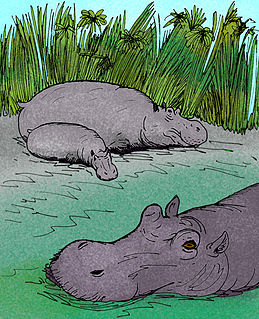 W
WHippopotamus gorgops is an extinct species of hippopotamus. It first appeared in Africa during the late Pliocene, and eventually migrated into Europe during the early Pleistocene. It became extinct during the Middle Pleistocene. Fossil records found at Ubeidiya, Israel suggested that they migrated out of Africa around 1.6 million years ago. Some have speculated that H. gorgops and H. behemoth are actually the same species given their similar sizes and where they have been found scientist believe it behaved almost identical to modern day hippopotamuses.
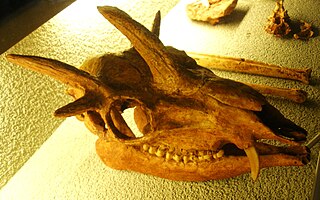 W
WHoplitomeryx is a genus of extinct deer-like ruminants which lived on the former Gargano Island during the Miocene and the Early Pliocene, now a peninsula on the east coast of South Italy. Hoplitomeryx, also known as "prongdeer", had five horns and sabre-like upper canines similar to a modern musk deer.
 W
WKolpochoerus is an extinct genus of the pig family Suidae related to the modern-day genera Hylochoerus and Potamochoerus. It is believed that most of them inhabited African forests, as opposed to the bushpig and red river hog that inhabit open brush and savannas. There are currently eight recognized species.
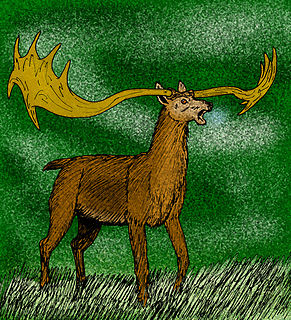 W
WLibralces was a genus of Eurasian deer that lived during the Pliocene epoch. Its main claim to fame are its 2+ meter wide antlers, comparable in size to those of Megaloceros.
 W
WMakapania is an extinct genus of large caprine or ovibovine from the Pliocene and Pleistocene of southern and East Africa. It is remarkable in that its horns were positioned laterally. Its body weight is estimated to have been about 263 kg.
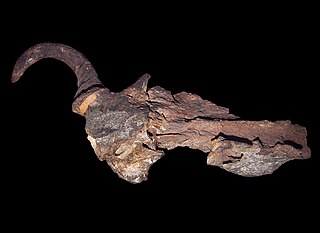 W
WMegalotragus was a genus of very large extinct African alcelaphines that occurred from the Pliocene to early Holocene. Its skull resembled that of modern hartebeests, but it differed in having a larger body size and wildebeest-like proportions. Megalotragus includes some of the largest bovid species in the tribe Alcelaphini, reaching a shoulder height of 1.4 m (4.6 ft). The genus consists of three species of which Megalotragus priscus survived until the early Holocene 7.500 C14yBP.
 W
WMegalovis is an extinct genus of bovid that lived in Eurasia during the Plio-Pleistocene.
 W
WMegatylopus is an extinct genus of large camel, endemic to North America from the Late Miocene to the Pliocene, existing for approximately 7.4 million years. Fossil distribution ranged from North Carolina to California. It stood about 4.2 metres (14 ft) tall.
 W
WMerycopotamus is an extinct genus of Asian anthracothere that appeared during the Middle Miocene, and died out in the Late Pliocene. At the height of the genus' influence, species ranged throughout southern Asia. With the extinction of the last species, M. dissimilis, the lineage of anthracotheres came to an end. Merycopotamus was closely related to the anthracothere genus Libycosaurus, which, unlike the former, never left Africa. In fact, some African fossils originally placed in Merycopotamus, but are now referred to Libycosaurus.
 W
WMetridiochoerus is an extinct genus in the pig family indigenous to the Pliocene and Pleistocene of Africa. It is also known as the giant warthog.
 W
WMitilanotherium is an extinct genus of giraffes from the Pliocene and Pleistocene of Europe.
 W
WMylohyus is an extinct genus of peccary found in North and Central America. It evolved in the Pliocene and its extinction is probably as recent as 9,000 years ago. It would have been familiar with early humans.
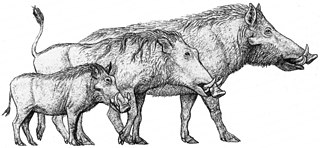 W
WNotochoerus is an extinct genus of very large pigs from the subfamily Tetraconodontinae. Fossils have been found in Africa, notably Uganda and Ethiopia.
 W
WNyanzachoerus is an extinct genus of the pig family (Suidae) belonging to the subfamily Tetraconodontinae. The several species of Nyanzachoerus lived in Africa from the Miocene to Pliocene.
 W
WParacamelus is an extinct genus of camel in the family Camelidae. It originated in North America during the Middle Miocene but crossed the Beringian land bridge into Eurasia during the Late Miocene, approximately 7.5–6.5 million years ago (Ma); its later range spanned from Spain and Italy to Chad and Shanxi Province, China. It is ancestral to living camels of the genus Camelus. A population remained in northern North America, which became the high Arctic camel, which survived until the Middle Pleistocene approximately 1 Ma.
 W
WPlatygonus is an extinct genus of herbivorous peccaries of the family Tayassuidae, endemic to North and South America from the Miocene through Pleistocene epochs, existing for about 10.289 million years. This species grew up to lengths of 3.3 feet long and stood 2.5 feet tall.
 W
WPraemegaceros is an extinct genus of deer. It also contains the subgenera Orthogonoceros and Nesoleipoceros. It has sometimes been synonymised with Megaloceros and Megaceroides, however they have been found to be generically distinct.
 W
WPropotamochoerus is an extinct genus of pig that lived from Miocene to Pliocene of Algeria, India, Moldova, China, Russia, Ukraine, Georgia, Greece, Hungary, Myanmar, Thailand, Tunisia and Pakistan.
 W
WProtoceratidae is an extinct family of herbivorous North American artiodactyls that lived during the Eocene through Pliocene at around 46.2—4.9 Mya, existing for about 41 million years.
 W
WSamotherium is an extinct genus of Giraffidae from the Miocene and Pliocene of Eurasia and Africa. Samotherium had two ossicones on its head, and long legs. The ossicones usually pointed upward, and were curved backwards, with males having larger, more curved ossicones, though in the Chinese species, S. sinense, the straight ossicones point laterally, not upwards. The genus is closely related to Shansitherium. Fossil evidence suggests that Samotherium had a rounded muzzle, which would suggest a grazing lifestyle and a habitat composed of grassland.
 W
WSivatherium is an extinct genus of giraffids that ranged throughout Africa to the Indian subcontinent. The species Sivatherium giganteum is, by weight, one of the largest giraffid known, and also one of the largest ruminants of all time. The Afro-Asiatic species, S. maurusium, was once placed within the genus "Libytherium".
 W
WSus strozzi, or Strozzi's pig, was a suid native to the Mediterranean region of Europe. It was more ancient than the boar, and was eventually displaced by the latter when it entered Europe during the start of the Pleistocene, 1 Mya.
 W
WTitanotylopus is an extinct genus of terrestrial herbivore in the family Camelidae, endemic to North America from the late Hemphillian stage of the Miocene through the Irvingtonian stage of the Pleistocene. It was one of the last surviving North American camels, after its extinction, only Camelops remained. Its closest living relative is the Bactrian Camel.